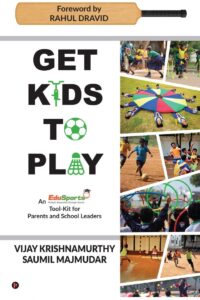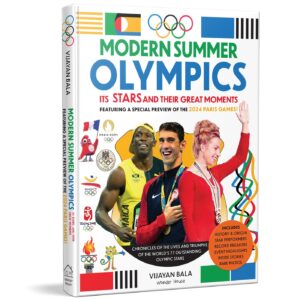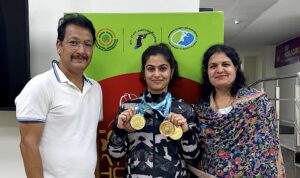
Some thoughts came up when reading the book, Dreams of a Billion. For one, the limited number of Indian heroes in the history of the Olympic Games. For another, the shortage of literature on India’s tryst with the Olympic Games is starkly evident. A number of journalists have covered to Olympic Games but left little for the future generations to read and get inspired by.
I thought it was best to park these thoughts aside and complete reading the tome put together by Boria Majumdar and Nalin Mehta and published by Harper Sport. They have adopted different narrative styles, the first one-third of the book using a modern story-telling approach while the rest follows an old-fashioned research-based narrative.
It means that the pioneering efforts of tennis star Leander Paes, weightlifter Karnam Malleswari and double trap shooter Col. Rajyavardhan Singh Rathore in instilling belief among millions of Indians have found little space. The reader also has to endure the disappointment of only a passing mention of boxer Vijender Singh, whose 2008 bronze medal inspired many youngsters.
It may have been better if Dreams of a Billion was written as a companion volume for India’s Olympic Story (2008 and 2012) rather than seek to straddle all 100 years of India’s participation in the quadrennial celebration of global sport. For all that, this will a good read for everyone interested in Olympic sport, the effort that an athlete makes in preparing for the Games.

Yet, with the Olympic Games less than six months away, Dreams of a Billion will be a good read for those who wish to bring themselves up to speed. With so little literature available on Indian Olympic sport, this book presents itself handily, given the effort by the authors, especially Boria Majumdar who has interviewed quite a few contemporary athletes.
The story of the Olympic badminton medalists in 2012 and 2016 and their successful coach is indeed an integral part of the India’s Olympic journey. The Saina Nehwal-PV Sindhu rivalry, including the former’s fallout and rapprochement with coach P Gopichand, finds much space in the book.
Though Parupalli Kashyap has been generously quoted in tracing Saina Nehwal’s journey, it is the voice of Gopichand that resonates through the two chapters that accord badminton the pride of place in the book. It may be just a line in the but Gopichand’s expression of disappointment at Prakash Padukone ‘never saying anything positive’ about him is telling, indeed.
At some point of time, it may help to examine if the Academy in Gachibowli would have been as successful but for the massive support from Ministry of Youth Affairs and Sports – last known, it had extended Rs 13 crore funding over five years for National Camps held at the SAI Gopichand Academy. However, a book on the Olympic Games may not be the best place for that.
Then again, it would have been apt to study the roles of overseas coaches, funded by the Ministry, at the Academy. And perhaps a bit more to find out why a stream of such coaches have left the Academy long before the Tokyo Olympic Games. This would have completed the presentation of the training base in Hyderabad as a ‘medal factory’.
Abhinav Bindra, India’s only individual Olympic Games gold medal winner, and MC Mary Kom, arguably boxing’s one-woman medal factory, have also got a chapter each in the first one-third of the book. Boria Majumdar’s encounters with them during their Olympic campaigns and elsewhere brings forth some critical insights into their mindset.
If there is one serious grouse that I have with the authors, it has to do with the rather kind reference to wrestler Narsingh Yadav, who found guilty of a doping rule violation. It does not go well with the achievements of several star featured in the book. He has been portrayed as a tragic-hero and a victim of the sport’s politics.
There is a suggestion – twice at that – the Wrestling Federation of India challenged the National Anti-Doping Disciplinary Panel verdict. The fact is that National Anti-Doping Disciplinary Panel, chaired by Sanjay Mani Tripathi and including Dr LK Gupta and Poonam Chopra, exonerated the wrestler of ingesting a prohibited substance.
So, there really is no question of the Federation going on appeal against that decision. Factual errors like this should have no place in a book that is the result of a lot of hard work. Perhaps, the authors needed a stronger editor who could verify such critical facts and ensure that the quality of the book does not get affected.
“Where is Narsingh Yadav today and what happened to him the past few years? Who is responsible for prematurely ending a promising athletic career? Is it fair to argue that without the Federation’s support, he would not have challenge the NADA ban? Could he have returned to wrestling after a much small suspension period that way?” the authors write.
Given that the Court for Arbitration in Sport handed Narsingh Yadav a four-year ban on August 18, 2016, it is clear that he cannot be back to competition till August 17 this year. And, as a standard practice, only the athlete is responsible for the doping violation that has conclusively taken place. And he has not been able to back his allegation of sabotage with any definite evidence.
While giving credit to the Bindra-chaired committee that ushered in some reforms in the National Rifle Association of India that governs shooting sport in the country, the authors have zeroed in on the reasons for raised expectations from the Indian shooting contingent in Tokyo, not much attention has been paid to many other sport.
“How good is India’s preparation for Tokyo 2020? Can Tokyo be the gamechanger Indian sports wants it to be and hopes it will be?” That the likes of javelin thrower Neeraj Chopra and boxer Amit Panghal find scant mention should prepare you to not look for definitive answers for the questions which stare you from the front flap cover.
It is fair to say that the authors’ focus is more on what has been achieved rather than what can be achieved in 2020. But it is in telling nostalgic tales of India’s success, however few and far between, that the authors succeed in holding the reader’s attention. And in continuing to plug the gap in Indian sports literature, they have tickled much interest among the Indian sports fans.





